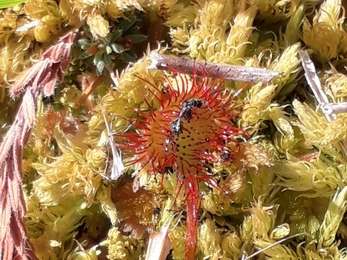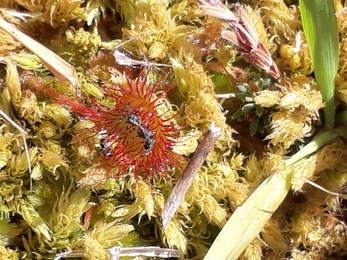Weekly wild news from our reserves, 19th June 2020
By Steve Aylward
Cottongrass is a member of the sedge family and so not technically a grass at all. It thrives in the harshest of environments where it can take advantage of the lack of competition. After fertilisation in early summer, the small, unremarkable green and brown flowers develop distinctive white seed-heads that resemble tufts of cotton. Combined with its ecological suitability to bogs, these characteristics give rise to the plant's alternative name, bog cotton. Blowing in the breeze, they bring isolated places to life in summer. Historically, common cotton-grass was used to stuff pillows in Suffolk and Sussex. It was also collected and used in Scotland to dress wounds during the First World War. Cottongrass is also the county flower of Manchester where the white plumes are a familiar sight in wet hollows on the moors above the city.
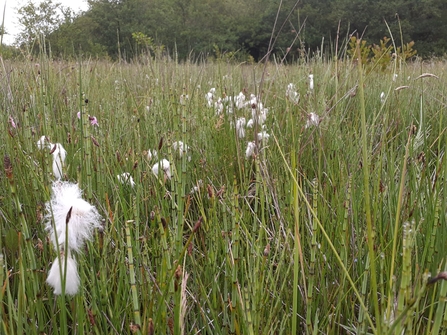
Cottongrass - Carl Ansell
European black slugs are out in force
Charlie McMurray, our Sizewell Belts Assistant Warden, spotted several European black slugs found at the top of flimsy vegetation this week. These species tend to come out in cloud cover or after periods of rain. Could this behaviour be due to higher moisture content found in the local atmosphere at this elevated position? Or perhaps it is a survival mechanism to avoid ground predators such as voles who are partial to the odd slug or two? Perhaps the slugs are under the influence of a parasitic menace?
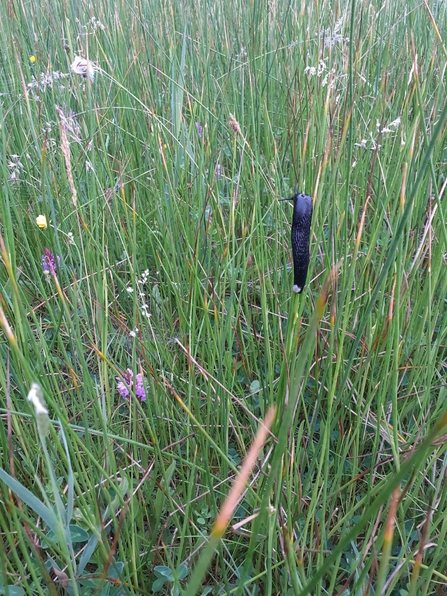
European black slug - Carl Ansell
Penny for your thoughts
Marsh Pennywort spreads out horizontally forming dense mats in shallow water, mud, or in marshes. It does not at first glance look like an umbellifer, but closer inspection of the fruits or of the flowers reveals the relationship; it was once called an atypical umbellifer but re-evaluation by taxonomists led them to move the Pennyworts out of the Umbellifer family into a new family they called Hydrocotylaceae which contains but one genus, Hydrocotyle to which the Pennyworts have been assigned.
This patch of pennywort was spotted this week by our Sizewell Belts Officer.
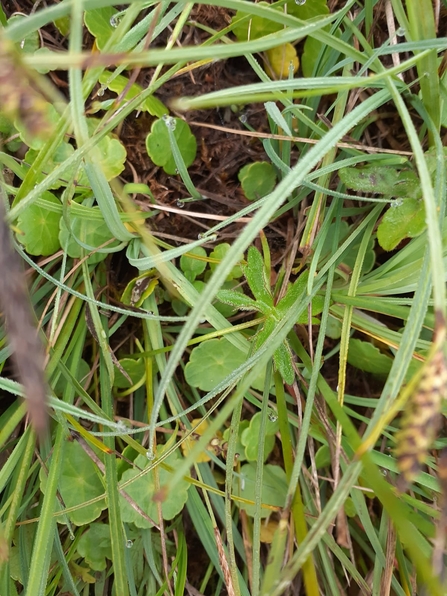
Pennywort - Carl Ansell
‘Zombies’ in our grasslands
South East Suffolk Sites Manager, Andrew Excell, took the time to stop and look a little closer at cowpats this week and explains some of the interesting behaviour that goes on.
Scathophaga stercoraria or yellow dung flies play a vital role in accelerating decomposition of dung. The fly’s scientific name translates as “dung eater” but only its larvae feed on the dung.
Dung flies’ behaviour and their sex lives have intrigued evolutionary biologists. Males vary in size and females tend to choose the largest mates available on the cowpat, with multiple mating being the norm. Adults are agile predators, whose hunting prowess translates into rapid growth and a better chance of sexual success. Whatever their size, hunting success or sexual prowess, most dung flies suffer the same fate. Swallows skimming the marsh vegetation, mouths agape, take their fill of flies that rise from the cowpats and nettles.
They are also prone to the insect-eating fungus Entomophthora which slowly proliferates. In their final hours the flies become zombies as the fungus takes control of their nervous system and compels them to climb towards the light until they reach the top of grass stems – where they are conspicuously positioned for passing on the infection to another generation.
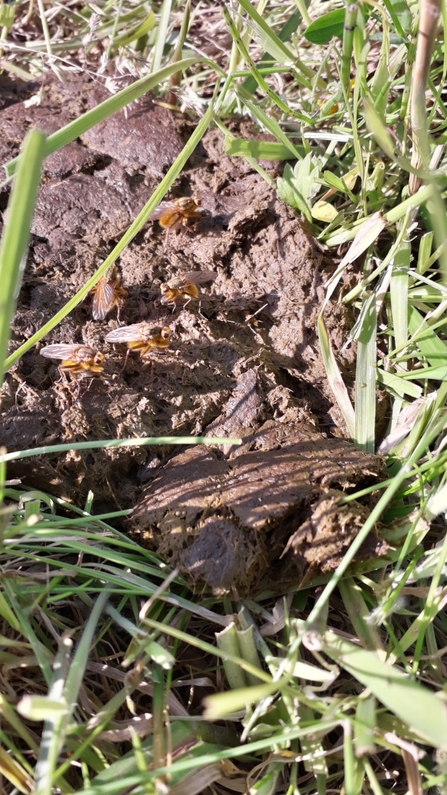
Yellow dung fly - Scathophaga stercoraria
Carnivores on the Fen
This carnivorous round-leaved sundew was spotted having an insect snack this week at Redgrave & Lopham Fen. Sundews do not get adequate nutrients from the acidic soil, so they have evolved to supplement their diet by consuming passing insects. Hair-like tendrils covered with glistening sticky dew stick insects to the leaves, which then wrap around the insect to digest it. These plants have a unique beauty, with greeny-red hairy leaves and pink or white flowers in summer. Historically the sundew has been used in cough medicines, and the dew of the sundew was believed to possess anti-aging properties.
Swift chick hatches at Lackford Lakes
The team at Lackford Lakes were delighted to catch a glimpse of a freshly-hatched swift chick in their nest box. Swifts migrate from Africa to breed and have been returning to the nest boxes at Lackford for several years. Swifts only land to nest, spending the rest of their lives on the wing, even sleeping, drinking and mating while flying.
Over the last 25 years there has been a decline of over 50% of the swifts we see. Find out how Suffolk Wildlife Trust is working to help swifts in Suffolk here.
Swift chick hatching at Lackford (https://youtu.be/ODUNK_neaZE )
Swift chick hatching at Lackford
Bandy on the marshes
The brown hare with its deep amber eyes, black-tipped long ears and fur flecked with black, brown, tan, gold and cream, has accumulated the most lore of any British mammal, despite having probably being bought over from Europe during the Iron Age. In Suffolk, often referred to as ‘Bandy’ in reference to its curved hind legs or bowen. Other colloquial names include Aunt Sarah, old aunt, Sarah, old Sarah, Sally, old Sally.
Brown hares live in exposed habitats and rely on their acute senses and running at speeds of up to 45mph to escape predators. Unlike rabbits, hares do not use burrows, instead they make a small depression in the ground among long grass called a ‘form’. They spend most of the day on or near the form, moving out to feed. Though generally solitary, hares sometimes band into loose groups when feeding.
Brown hares have been delighting visitors at Carlton Marshes as they enjoy the lush long grass and speedy access up the visitor tails.
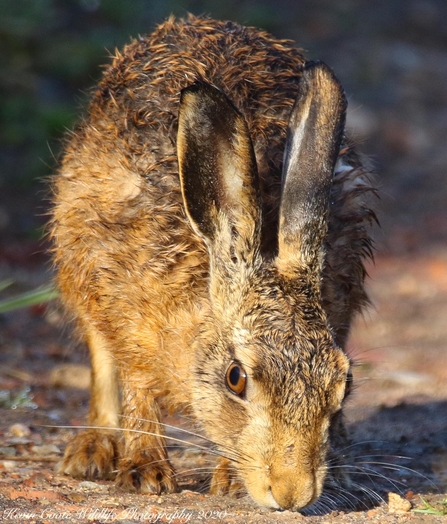
Brown Hare - Lepus europaeus - Kevin Coote
Kevin Coote captured this fantastic picture of two hares catching a heron off guard and frightening it into flight.
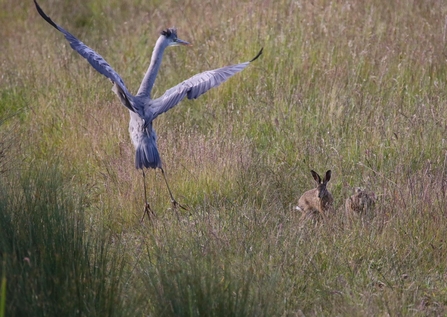
Heron scared by Hare, Carlton Marshes - Kevin Coote
Grey Mullet on the Blyth
Jamie Smith, our North East Suffolk Warden, has captured a shoal of grey mullet swimming up the Blyth at Hen Reedbeds.
The term mullet is often used for fish with a large spiny dorsal fin (it has nothing to do with the hairstyle, which is from the French fashion guru Henri Mollet).
Grey mullet feed on algae and are often swimming in muddy brackish water, in harbours or near sewerage outfalls, making them mostly unsuitable for eating.
There are three species of grey mullet found in the UK, thick-lipped grey, thin-lipped grey and golden-grey mullet.
Grey Mullet - Hen Reedbeds, Jamie Smith (https://youtu.be/a5DEtqN5mR0)
Grey Mullet - Hen Reedbeds, Jamie Smith


